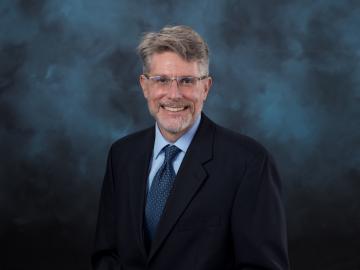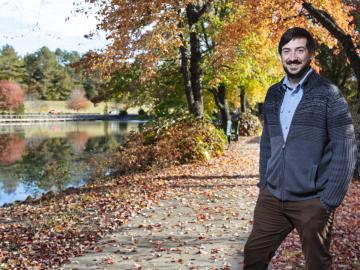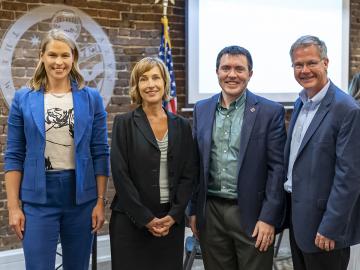
Filter News
Area of Research
- (-) Biology and Environment (49)
- (-) Energy Science (97)
- (-) Neutron Science (20)
- Advanced Manufacturing (3)
- Biology and Soft Matter (1)
- Building Technologies (1)
- Computational Biology (1)
- Computational Engineering (3)
- Computer Science (16)
- Electricity and Smart Grid (3)
- Functional Materials for Energy (1)
- Fusion and Fission (28)
- Fusion Energy (15)
- Isotopes (1)
- Materials (37)
- Materials for Computing (7)
- Mathematics (1)
- National Security (45)
- Nuclear Science and Technology (12)
- Quantum information Science (6)
- Sensors and Controls (1)
- Supercomputing (116)
- Transportation Systems (1)
News Topics
- (-) Artificial Intelligence (20)
- (-) Computer Science (50)
- (-) Cybersecurity (9)
- (-) Fusion (2)
- (-) Grid (40)
- (-) Machine Learning (17)
- 3-D Printing/Advanced Manufacturing (83)
- Advanced Reactors (6)
- Big Data (16)
- Bioenergy (70)
- Biology (84)
- Biomedical (33)
- Biotechnology (17)
- Buildings (38)
- Chemical Sciences (22)
- Clean Water (21)
- Composites (19)
- Coronavirus (29)
- Critical Materials (9)
- Energy Storage (75)
- Environment (143)
- Exascale Computing (6)
- Fossil Energy (3)
- Frontier (6)
- High-Performance Computing (25)
- Hydropower (10)
- Isotopes (2)
- Materials (49)
- Materials Science (50)
- Mathematics (6)
- Mercury (10)
- Microelectronics (1)
- Microscopy (17)
- Molten Salt (1)
- Nanotechnology (20)
- National Security (9)
- Neutron Science (121)
- Nuclear Energy (9)
- Partnerships (13)
- Physics (11)
- Polymers (13)
- Quantum Computing (1)
- Quantum Science (8)
- Security (8)
- Simulation (18)
- Space Exploration (6)
- Statistics (1)
- Summit (17)
- Transportation (69)
Media Contacts

Oak Ridge National Laboratory scientists designed a recyclable polymer for carbon-fiber composites to enable circular manufacturing of parts that boost energy efficiency in automotive, wind power and aerospace applications.

As the United States shifts away from fossil-fuel-burning cars and trucks, scientists at the Department of Energy’s Oak Ridge and Argonne national laboratories are exploring options for another form of transportation: trains. The research focuses on zero-carbon hydrogen and other low-carbon fuels as viable alternatives to diesel for the rail industry.

Laboratory Director Thomas Zacharia presented five Director’s Awards during Saturday night's annual Awards Night event hosted by UT-Battelle, which manages ORNL for the Department of Energy.

ORNL appointed Peter Thornton as director of its Climate Change Science Institute, or CCSI, effective November 1, 2022.

Matthew Craig grew up eagerly exploring the forest patches and knee-high waterfalls just beyond his backyard in central Illinois’ corn belt. Today, that natural curiosity and the expertise he’s cultivated in biogeochemistry and ecology are focused on how carbon cycles in and out of soils, a process that can have tremendous impact on the Earth’s climate.

Scientists working on a solution for plastic waste have developed a two-step chemical and biological process to break down and upcycle mixed plastics into valuable bioproducts.

Researchers at ORNL recently demonstrated a new technology to better control how power flows to and from commercial buildings equipped with solar, wind or other renewable energy generation.

A crowd of investors and supporters turned out for last week’s Innovation Crossroads Showcase at the Knoxville Chamber as part of Innov865 Week. Sponsored by ORNL and the Tennessee Advanced Energy Business Council, the event celebrated deep-tech entrepreneurs and the Oak Ridge Corridor as a growing energy innovation hub for the nation.

Two years after ORNL provided a model of nearly every building in America, commercial partners are using the tool for tasks ranging from designing energy-efficient buildings and cities to linking energy efficiency to real estate value and risk.

When Hurricane Maria battered Puerto Rico in 2017, winds snapped trees and destroyed homes, while heavy rains transformed streets into rivers. But after the storm passed, the human toll continued to grow as residents struggled without electricity for months. Five years later, power outages remain long and frequent.


